Bringing Home a New Puppy: Essential Tips for a Smooth Transition
Bringing home a new puppy is an exciting adventure that fills our hearts with joy and our homes with wagging tails.
As you embark on this journey of puppy parenthood, it's crucial to understand what to expect and how to prepare for your furry friend's arrival.

A smooth transition not only ensures your puppy's comfort but also sets the foundation for a loving, lifelong bond between you and your new companion.
This guide, will walk you through essential tips to make your puppy's homecoming a success. It covers how to prepare your home, what to do in the first 24 hours, basic training techniques, and ways to keep your puppy healthy and safe.
From setting up sleeping arrangements to starting socialization, you'll receive practical advice to help you and your new puppy adjust to life together.
So, let's dive in and get ready to welcome your adorable new family member!
Preparing Your Home for the New Arrival
Puppy-proofing Essentials
Before bringing home a new puppy, it's crucial to make your house safe and secure. We need to walk through every room, imagining what a curious pup might chew, climb, or pull down.
Getting down on your hands and knees can help you spot potential hazards in your home from a puppy's perspective.
Dogs smell their way through life starting as puppies so trash cans will definitely get your new pups attention. Make this a starting point by securing trash cans with locking lids or placing them in closed cabinets.
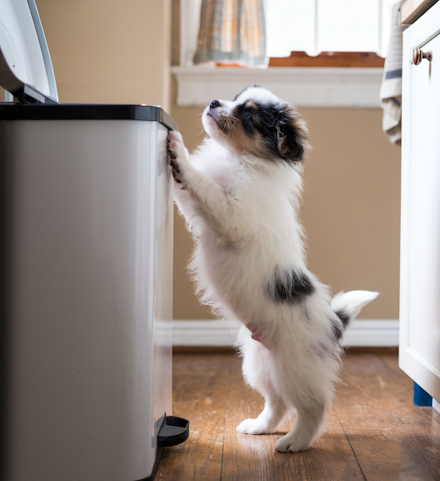
It's also important to remember that many common food items like grapes, onions, and chocolate can be toxic to dogs.
We also need to keep an eye out for small objects that could be choking hazards.
Electrical cords are another major concern when preparing for a puppy. In this case, you can use cord covers or deterrent sprays to protect your new friend from accidental shocks or burns.
It's also a good idea to secure any furniture that could tip over if a puppy tries to climb it.
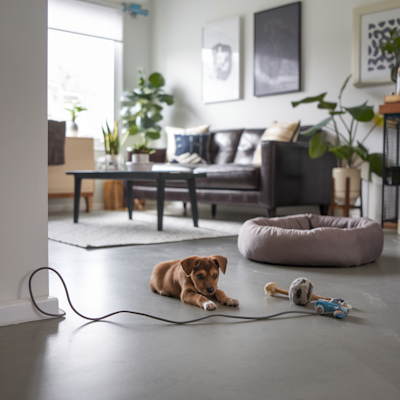
Creating A Safe Space
Our puppy will need a designated area where they can feel secure and comfortable. This space should be quiet and stress-free, allowing our new companion to relax and unwind.
A crate often serves as an excellent safe space for puppies.
When choosing a crate, we need to make sure it's the right size. It should be just big enough for our puppy to stand, turn around, and lie down comfortably. Many crates come with dividers that we can adjust as our puppy grows.
We can make the crate more inviting by adding a comfortable bed and some safe toys. It's important to remember that this space should never be used for punishment.
Instead, we want our puppy to associate it with positive experiences.
Gathering Necessary Supplies
To prepare for our new puppy's arrival, you need to stock up on some essential supplies.
- Dog ID tag with your dog's name, plus your name and phone number. This should be a number that you always answer or is forwarded to where you are. This is a very important part of your pet's lifetime safety. That along with micro-chipping.
- We'll also need food and water bowls - consider getting ones that are spill-proof or have a non-slip bottom.
- Don't forget to pick up some treats for training and bonding sessions.
- Toys are essential for keeping our puppy entertained and redirecting their chewing instincts away from our belongings. A variety of chew toys, puzzle toys, and soft plush toys can help meet different needs.
- For house training, you might want to consider puppy pads, especially if you live in an apartment or have limited outdoor access. However, it's important to use these strategically to avoid confusion during the potty training process.
Puppy-appropriate food is crucial for your new friend's health and development. Your veterinarian can help you choose the best option when you take your puppy for his first health check shortly after you bring him home.
Lastly, we shouldn't forget about grooming supplies. A puppy-safe shampoo, gentle brush, and nail clippers will help you keep your new friend clean and comfortable.
By taking these steps to prepare your home, you'll be setting the stage for a smooth transition when bringing home a new puppy.
With a safe environment and all the necessary supplies, you'll be ready to welcome your furry friend and start your journey together on the right foot.
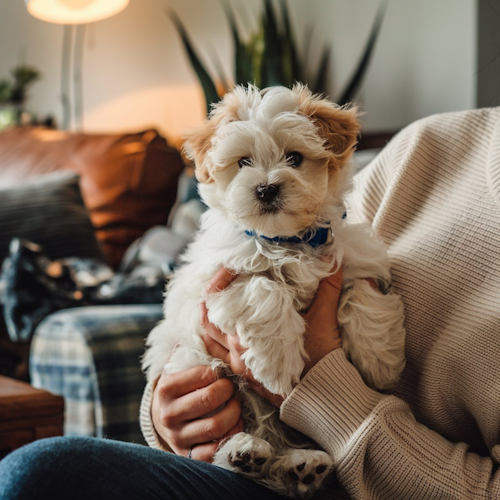
The First 24 Hours: Helping Your Puppy Adjust
Establishing A Routine
When bringing home a new puppy, it's crucial to establish a routine right from the start. I've found that structure helps our furry friend feel secure and understand what's expected of them.
On the first day, make sure to set up a consistent schedule for feeding, potty breaks, playtime, and rest.

Start by showing your new puppy the designated potty area outside. Every time he eats, drinks, wakes up from a nap, or finishes playing, take him to this spot.
It's important to use the same command, like "go potty," and praise your puppy immediately when he hoes his business. This consistency is key to successful housebreaking.
For feeding, stick to the schedule recommended by the breeder or shelter. Most young puppies eat three times a day, so plan meals accordingly. Also, make sure to have plenty of fresh water available throughout the day.
Managing The First Night
The first night with a new puppy can be challenging, but I've learned some tricks to make it easier.
I usually set up the puppy's crate in my bedroom, which helps them feel more secure. To create a cozy environment, I put a soft blanket that came with them or toy that smells like their litter mates in the crate.
If your puppy has a harder time settling down at night because he feels lonely or is missing his litter mates, you can try a neat toy that has proved to be a helpful bed time buddy.
Snuggle Puppy is a stuffed toy with a real-feel heartbeat that has a calming effect on puppies reducing anxiety and helping them fall asleep. Many pet parents describe it as a godsend.
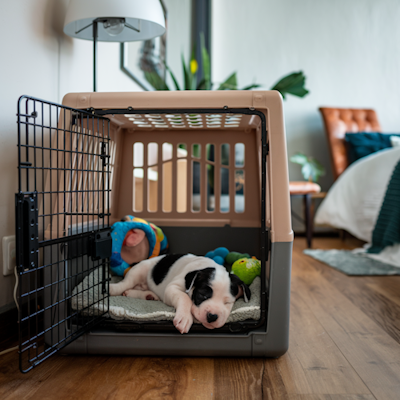
Before bedtime, I take my puppy out for a final potty break and remove their water bowl about an hour before sleep.
I keep interactions calm and quiet to help them wind down. It's normal for puppies to whine or cry during the night, but I resist the urge to cuddle them every time they make a noise.
Instead, I speak in soothing tones and only take them out if I think they genuinely need to relieve themselves.
Introducing Family Members
When introducing your new puppy to family members, take it slow and keep things calm. Have everyone approach the puppy gently, speaking in soft voices. It's important to let the puppy come to them rather than forcing interactions.
Supervise all introductions closely, especially with children. Teach kids how to pet the puppy gently and respect their space. If the puppy seems overwhelmed, I give them a break in their safe area.
If there are other pets in your household, make introductions gradually and in neutral spaces. Always ensure that each animal has their own safe space to retreat to if needed. This helps prevent any tension and allows everyone to adjust at their own pace.
Remember, bringing home a new puppy is an exciting time, but it's also a big adjustment for everyone involved.
By establishing a routine, managing the first night carefully, and introducing family members slowly, you can help your new furry friend settle in and start building a strong bond from day one.
Essential Training Basics
Crate Training Techniques
Crate training is a valuable tool when bringing home a new puppy. It provides a safe space for your furry friend and is invaluable with housebreaking.
To start, choose a crate that's just big enough for your puppy to stand, turn around, and lie down comfortably. Alternatively, you can select a crate with dividers that can be adjusted as your puppy grows.
Make the crate inviting by adding a soft bed and some safe toys.
Introduce your puppy to the crate gradually. Begin by leaving the door open and encouraging them to explore it on their own.
You can toss treats inside to make it more appealing. Once your puppy is comfortable entering the crate, start feeding them their meals inside. This creates a positive association with the space.
As your puppy gets used to the crate, you can start closing the door for short periods while they eat.
Gradually increase the time they spend inside, always making sure it's a positive experience.
The crate should never be used as punishment, as this will create negative associations and slow down the training.
Potty Training Tips
Consistency is key when it comes to potty training your new puppy. Establish a regular schedule for feeding, playtime, and potty breaks.
Take your puppy outside frequently, especially after meals, naps, and playtime. Choose a specific spot outdoors for them to do their business and use a consistent command like "go potty."
When your puppy successfully eliminates outside, praise them enthusiastically and offer a small treat as a reward.
This positive reinforcement helps them understand what you want them to do. If accidents happen indoors, don't scold your puppy. Instead, calmly clean up the mess using an enzymatic cleaner to remove any lingering odors.
Remember that young puppies have small bladders and limited control. My best advice is to take your new puppy out for a potty break every 30 minutes unless he is sleeping. Do this until you get a good idea of his typical needs.
No two puppies are alike, so you may find at 8 weeks old he can last an hour, but observation will tell the tale.
You can read more details about potty training a puppy here.
Basic Commands To Start With
Starting with simple commands helps build a strong foundation for your puppy's training. Two essential commands to begin with are "sit" and "come."
These will be useful throughout your dog's life and are relatively easy for puppies to learn.
To teach "sit," hold a treat close to your puppy's nose and slowly move your hand up and back over their head. As their head tilts back to follow the treat, their bottom will naturally lower to the ground. As soon as they sit, say "good!" and give them the treat.
For "come," start in a quiet area with few distractions. Say your puppy's name followed by "come" in a cheerful voice. When they come to you, praise them enthusiastically and offer a treat.
Gradually increase the distance and add distractions as your puppy becomes more reliable with the command.
Remember to keep training sessions short, around 5-10 minutes, as puppies have short attention spans.
Always end on a positive note to keep your puppy eager for the next session.
With patience, consistency, and lots of positive reinforcement, you'll be well on your way to having a well-trained companion.
Health and Wellness: Starting Off Right
Scheduling The First Vet Visit
When bringing home a new puppy, one of your top priorities should be scheduling their first veterinary visit.
I always recommend doing this within the first few days of welcoming your furry friend home. This initial checkup is crucial for establishing a baseline for your puppy's health and starting them on the right path.
During this visit, the vet will perform a thorough physical examination. They'll check your puppy's weight, listen to their heart and lungs, and examine their eyes, ears, nose, and mouth.
The vet will also palpate their abdomen and lymph nodes to check for any abnormalities.
It's a good idea to bring a stool sample to this appointment, as the vet will want to check for the presence of intestinal parasites, which are common in puppies.
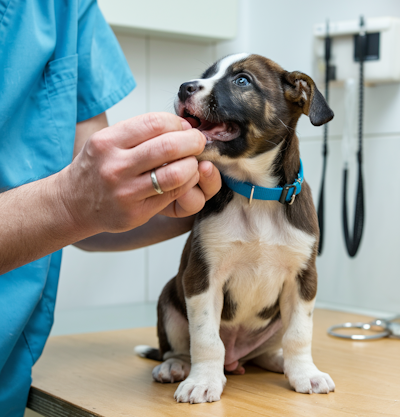
Vaccination And Parasite Prevention
Vaccinations are a critical aspect of puppy health care. The first round of shots typically starts when puppies are 6 to 8 weeks old.
Core vaccines, which are essential for all puppies, include those for distemper, parvovirus, and hepatitis. Rabies vaccination is usually given a bit later, around 3 to 4 months of age.
Parasite prevention is another crucial aspect of puppy health care. Many puppies are born with roundworms or acquire them from their mother's milk.
Regular de-worming is necessary to keep these parasites under control. We'll also need to start our puppy on heart worm prevention, usually around 8 weeks of age.
Flea and tick prevention is important too. There are various options available, including topical treatments, oral medications, and collars. Your vet can help you choose the best option based on your puppy's needs and lifestyle.
Nutrition And Feeding Guidelines
Proper nutrition is vital for your puppy's growth and development.
Puppies have different nutritional needs than adult dogs, so it's important to feed them a diet specifically formulated for puppies. These foods are higher in protein and calories to support their rapid growth.
The amount you feed your puppy will depend on their age, breed, and expected adult size.
As a general rule, puppies need to eat more frequently than adult dogs - usually three to four times a day until they're about six months old. It's important not to overfeed, as obesity can lead to health problems later in life.
You should always have fresh water available for your puppy.
As they grow, you'll need to adjust their food intake based on their body condition. Your vet can guide you on how to assess your puppy's body condition and make necessary adjustments to their diet.
Remember, bringing home a new puppy is an exciting time, but it comes with a lot of responsibility.
By focusing on these health and wellness aspects from the start, you're setting your puppy up for a long, healthy, and happy life.
Wrapping It Up
Bringing home a new puppy is a journey filled with joy, challenges, and countless learning opportunities.
From puppy-proofing our homes to establishing routines and starting basic training, every step plays a crucial role in setting up our furry friends for success.
The first few days and weeks are especially important to help puppies adjust and feel secure in their new environment.
As you embark on this exciting adventure of puppy parenthood, it's essential to remember that patience, consistency, and love are key ingredients.
By focusing on proper health care, nutrition, and training from the start, we're laying the groundwork for a strong, lifelong bond with our new companions.
With the right preparation and mindset, we can make the transition smooth and enjoyable for both our puppies and ourselves, paving the way for years of happiness and companionship ahead.
Before You Go...
If you like the content of this page, as well as others on my site, please give it some love by clicking on the heart in the lower right hand corner. This helps me to keep providing enjoyable and useful content.
Thank you.
- Always consult your veterinarian when you have health-related questions or you think your dog is sick. Information on this website is not intended to replace the advice of a qualified professional. The information above is designed to help inform you about the topic..
Using this information is at your own discretion and we will not be liable for any actions taken by any person or any consequences that may result.

